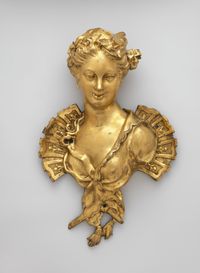
Venus Urania
Giambologna
An item at Metropolitan Museum of Art
Formerly in the collection of J. Pierpont Morgan, this gilded figure was published in Wilhelm von Bode’s 1910 catalogue of the American financier’s bronzes. Judging it an “early copy of a figure of larger dimensions by Gian Bologna,” Bode assigned it to one of the master’s followers without specifying a precise model, instead giving it the generic title of “Girl Bathing.” The statuette, which entered The Met in 1932, is a reduction of a celebrated bronze in Vienna (p. 00, fig. 126a), signed GIO BOLONGE and listed in imperial inventories from the mid-eighteenth century as a Venus Urania, surely for the presence of the armillary sphere, an astronomical instrument, at her feet. The composition is documented through several copies and variants in different materials, from bronze to ivory and wood.[1] Our statuette faithfully repeats several elements of the model, including the sphere at the base of the supporting pillar, the neatly truncated drapery at the back, and the decorative tooling of the fabric. Of particular note is the complex entwining of the right index finger with the strap that winds around the nude woman’s back and shoulder. Stylistically, however, The Met bronze cannot be directly linked to either Giambologna’s workshop or to his followers. In fact, the use of brass in the casting points to a non-Italian origin.[2] Manfred Leithe-Jasper assigned a Northern provenance to another reduction of Giambologna’s invention (albeit more freely adapted from the Vienna model) now in the Stift Klosterneuburg, pointing to the likely production of reductions after the Astronomy north of the Alps.[3] The disharmony between the thin disk on which our figure stands and the bulky molded base suggests that the two elements were not created contemporaneously. The remains of a pin in the support might indicate that the figure served an ornamental purpose and was adapted to a larger structure such as a piece of furniture or a program of interior decoration. -TM Footnotes (For key to shortened references see bibliography in Allen, Italian Renaissance and Baroque Bronzes in The Metropolitan Museum of Art. NY: The Metropolitan Museum of Art, 2022.) 1. For a list of copies and variants, see Manfred Leithe-Jasper in Paolozzi Strozzi and Zikos 2006, p. 204, cat. 22. 2. R. Stone/TR, March 28, 2011. 3. C. Avery et al. 1978, p. 93, cat. 12b.
European Sculpture and Decorative Arts
An exhibit at Metropolitan Museum of Art
The fifty thousand objects in the Museum's comprehensive and historically important collection of European sculpture and decorative arts reflect the development of a number of art forms in Western European countries from the early fifteenth through the early twentieth century. The holdings include sculpture in many sizes and media, woodwork and furniture, ceramics and glass, metalwork and jewelry, horological and mathematical instruments, and tapestries and textiles. Ceramics made in Asia for export to European markets and sculpture and decorative arts produced in Latin America during this period are also included among these works.




